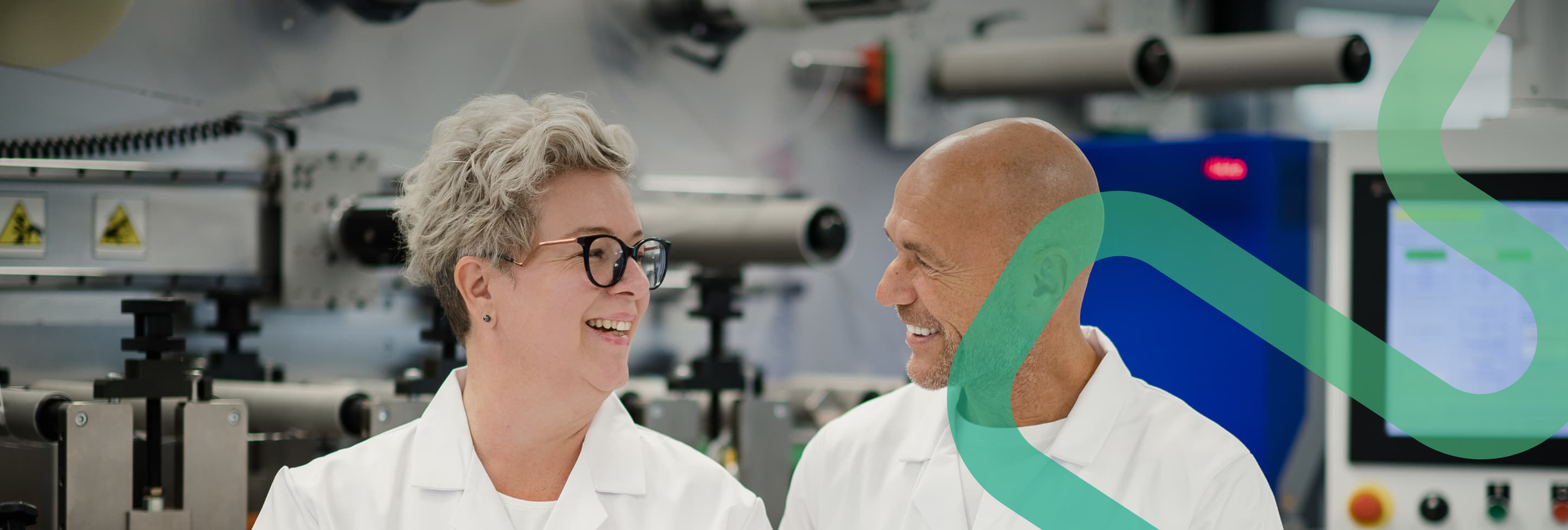Linxens electrodes: A cost-effective & high-quality alternative to standard gold electrodes

The Point-of-Care market is facing an increased need for mass volume solutions to generalize patient monitoring. Thanks to its reel-to-reel manufacturing and know-how capabilities, Linxens is able to design and manufacture high volumes solutions and to develop advanced transceiver electrochemical strip solutions. The Linxens electrodes’ response signal is stable and well-defined and demonstrates a great reversibility and stability over cycling in the presence of Ferrocene Methanol. In blanks, a stable signal is obtained between -0,3 to + 0,3 V vs Ag/AgCl in PBS, and between -0.3V to 1.5V vs Ag/AgCl in PB.
Authors:
Youssef Ben M’Barek, Innovation Engineer
Simon Vassal, Innovation Manager
Linxens electrodes are based on a complex yet well mastered process, allowing the high scale manufacturing of customer specific Flexible Printed Circuit Boards (FPCB) that have proven to be an excellent and cost-effective alternative to standard screen printed or sputtered electrodes.
We can summarize this process as follows: On a copper foil, the electrode’s design is patterned using a photolithographic process followed by a chemical etching. The resulting conductive traces can then be used as a seed layer on top of which a Nickel layer is electroplated. Then a functional gold layer is applied selectively to ensure the right coverage of the under layers on the sensing area while a thinner layer is deposited on the non-functional areas leading to a cost optimized design.
Linxens electrodes are made from stacks of different materials. Most substrates are comprised of polyimide 50µm or PET 150µm and a sheet of copper of 18 µm glued onto the substrate and chemically patterned to the desired design. A thick layer of nickel is electroplated of top of the copper and completed with a few hundred nanometers of gold.
Linxens has been refining its electroplating technology recently to achieve a great command of the surface’s microstructure and purity, leading to a highly engineered product particularly suitable for electrochemical biosensing applications. Hereafter is an example of Linxens electrodes electrochemical behavior under different conditions.
I – Electrochemical Response in the presence of 1mM Ferrocene Methanol (FeMeOH) in PBS:
To assess the electrodes’ sensitivity and the quality of the electrons transfer to a redox probe, multiple CVs have been recorded using Linxens’ Open Tool 4 (OT4) as a working electrode, in the presence of FeMeOH. A stable and well-defined signal is obtained, displaying a great reversibility and stability over cycling as shown on Fig.2 – (a). Moreover, using Randles Sevcik equation [1], the linear dependence of the peak current in function of the scan rate’s square root can be calculated, as demonstrated in Fig.2 – (b), with an R2 > 0.99.
The same experiment was performed using a commercial gold electrode and the recorded signal overlaid with the OT4’s CV as shown in Fig.3. Despite the price difference, the sensitivity of Linxens’ electrodes is similar to the massive gold ones (Metrohm/61204140), proving the former to be a great option when considering the high scale production of gold-based biosensors. Moreover, this CV was recorded using the OT4 without any cleaning pretreatment (no polishing, no chemical or physical treatment) and can serve as a proof for the quality of Linxens’ process, resulting in a pristine gold surface.
II – Blank Cyclic Volammograms:
Since the presence of a redox probe can hide smaller signals, blank CVs were recorded in the presence of different electrolytes to assess the electrodes surface state. The results of the blank CV of two of the most used electrolytes in biological applications, Phosphate Buffer (PB) and Phosphate Buffer Saline (PBS) are presented in the diagrams a and b. It should be noted that performing blank CVs could alter the surface state, especially in the presence of non-innocent species such as chloride[2,3,4], as demonstrated in the following sections.
a – Blanks in Phosphate Buffer (PB):
In PB, a noise free CV was recorded using OT4 as a working electrode, as can be observed in Fig.5. The typical oxidation and reduction peaks of a gold surface are obtained, and the signal remained stable over a wide potential range (from -0.3V to 1.5V vs Ag/AgCl). This stability in oxidative conditions is critical when designing electrochemical biosensors since most of the point of care applications occur at positive potential.
It should be noted that, depending on the electrode design, a small signal (peak height in the uA range) can be observed around 0.2V vs Ag/AgCl, as shown in Fig.5 – (a). This signal is stable over cycling and this phenomenon will not lead to any degradation of the electrode. Nevertheless, this signal is stable over cycling and, if needed, it can be suppressed by a fine engineering of the electrode’s construction, as shown in Fig.5 – (b).
b – Blank in Phosphate Buffer Saline (PBS):
The main difference between PB and PBS is the presence of chloride ions. As described in the literature, chloride affinity with gold can promote its dissolution through soluble complex formation when working at oxidative potentials, above +0,5 V vs Ag/AgCl[2,3,4]. It is advised to remain below this limit to avoid damaging Linxens’ electrodes and expose the under layers.
A stable signal is obtained between -0,3 to + 0,3 V vs Ag/AgCl in PBS. In the presence of chloride, a redox couple can be observed as shown in Fig.6 – (a). Similarly to the experiments performed in PB, the optimization of the electrode’s construction allows to modulate this signal, leading to a stable signal even in the -0.5V to 0.5V vs Ag/AgCl potential window as demonstrated in Fig.6 – (b).
Conclusion:
Overall, electrochemical biosensing is a fast-growing industry and Linxens products are able to match the market needs in a cost-effective way regarding the electrodes supply. One of the key advantages of Linxens’ process is its versatility which allows a fine control over the design, the materials and the construction of the electrodes towards developing a quality sensor at industrial level. One of the main concerns of electrochemists developing FPCB based point of care devices is the access to the underlayers. The above-mentioned experiments have demonstrated that Linxens’ electrodes response is stable in different supporting electrolytes and showed great reversibility and stability over cycling in the presence of FeMeOH. This is thanks to its electroplating process allowing to manufacture gold specific design electrodes suitable for biosensing applications.
References:
[1]. K.B. Oldham; J. Electroanal. Chem. 105 (1979) 373—375.
[2]. S. Cherevko & al; RSC Adv. 3 (2013), 16516-16527.
[3]. D.R. Ramirez-Rico & al, J. Electrochem. Soc. 164 (2017) H994.
[4]. B. Medgyes & al; Materials. 14 (2021), 5237.
Download article
